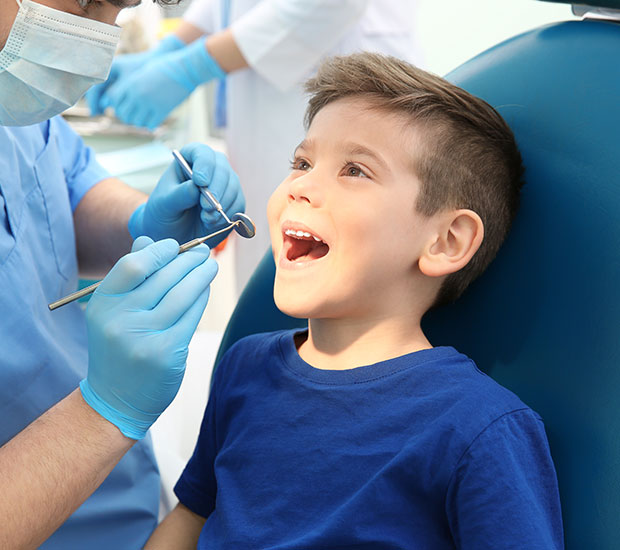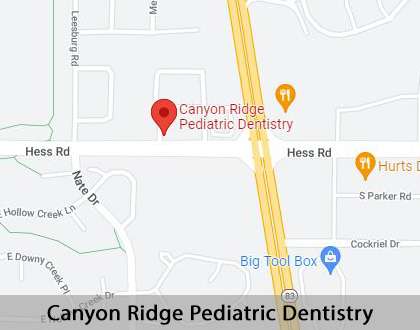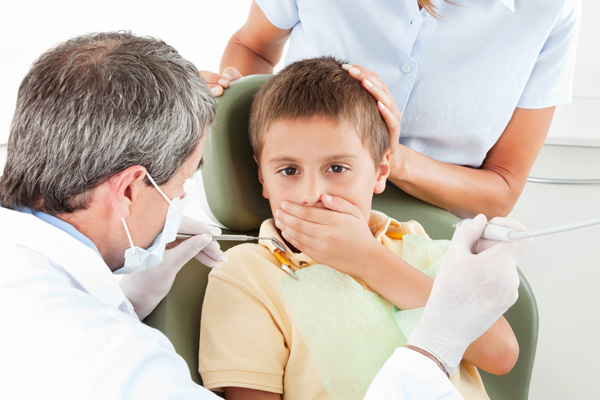What Can I Do if My Child Has Cavities Parker, CO
Finding out that your child has a cavity can be an unwelcome shock. Unfortunately, some children are at high risk for tooth decay. Even with good oral hygiene, cavities can still develop. A pediatric dentist can clear the decay, fill the tooth, and help prevent future cavities.
Cavity treatment is available at Canyon Ridge Pediatric Dentistry in Parker and the surrounding area. Our team offers on-the-spot care for families struggling with cavities. We provide preventive treatments that reduce a child's risk of future cavities. Call us at (303) 841-7900 to learn more.
Cavity Prevention
Good oral hygiene is the clearest way to prevent cavities. If your child is not in the habit of twice-daily brushing and flossing, it may be time to change that. Ask the dentist to demonstrate proper brushing and flossing techniques. A pediatric dentist can explain how to avoid cavities and can recommend a certain toothpaste or mouthwash.
If a child has braces, they might be at a higher risk of cavities. Braces can trap food particles against the teeth and gums. Kids with braces must be especially diligent about their oral health. Ask the dentist or orthodontist how to clear food particles from orthodontic appliances as specialized products can help reach small crevices.
Fluoride rinses can help, too. Fluoride is a mineral that strengthens tooth enamel and protects against decay. Many cities add fluoride to drinking water. If this is not the case, make sure to use a toothpaste that contains fluoride. Dentists can also provide a fluoride varnish during each checkup. This simple in-office procedure can lower your child's risk of cavities.
“Good oral hygiene is the clearest way to prevent cavities.”
A Cavity-Prevention Diet
Unfortunately, sugar is the most common cause of cavities. Bacteria in the mouth feed off of sugar and carbohydrates. As the bacteria feed, they produce an acid that damages tooth enamel, leading to tooth decay over time.
Eliminating sugar from children's diets may help prevent cavities. Limit sweets to a single serving each day, at most. Children should brush their teeth immediately afterward. Avoid sugary drinks like soda and undiluted juice. These beverages spread sugar across the mouth, providing a breeding ground for bacteria.
If your toddler still uses a bottle, consider transitioning them to an adult cup. Otherwise, avoid bedtime feedings and do not put the child to bed with a bottle or sippy cup. These practices can lead to early tooth decay.
Making Household Changes After a Cavity Diagnosis
If a child has a cavity, take a closer look at their oral hygiene routine. Have the child commit to brushing and flossing every morning and night. A sticker chart or reward system can help children stay on track. Use a timer or an electric toothbrush to make sure that they are brushing for a full two minutes.
Supervise the child as they brush and floss. Even responsible children can sometimes be lazy about oral hygiene. Busy families might find it helpful to brush and floss in the same bathroom. Taking care of oral hygiene as a family reinforces healthy dental habits.
“Eliminating sugar from children’s diets may help prevent cavities.”
Professional Cavity Treatments
If a child has a cavity, they will need a filling. This treatment keeps the decay from worsening. If the cavity is not filled, the decay might spread, and the child may need a root canal or extraction. Early treatment is essential for avoiding these outcomes.
During a filling, the dentist numbs the child's mouth. They drill out the decay and fill the tooth. Modern fillings are tooth-colored and invisible to the naked eye. Simple filings can be performed in about 30 minutes. If the child has several cavities, treatment may take longer. In some cases, the dentist may spread out the treatment over multiple visits. Performing the treatment in stages keeps young children from getting restless.
“If the cavity is not filled, the decay might spread, and the child may need a root canal or extraction.”
Check out what others are saying about our dental services on Yelp: What Can I Do if My Child Has Cavities in Parker, CO
Cavity Signs and Symptoms
Parents should get in the habit of examining their infant and toddler's mouths. Look for signs of decay, like tooth discoloration. Pay attention to your child's feeding habits, too. If they are reluctant to chew or they avoid hot and cold food, that might be a sign of a cavity.
Older children can usually verbalize their symptoms. If a child reports tooth pain or sensitivity, see a dentist right away. The sooner the cavity is detected, the sooner it can be treated. Treatment lowers your child's risk of severe decay.
“If a child reports tooth pain or sensitivity, see a dentist right away.”
Questions Answered on This Page
Q. How can I reduce my child's risk of cavities?
Q. What dietary changes can lower my child's risk of cavities?
Q. What are some early warning signs of cavities?
People Also Ask
Q. What are the cavity treatment options?
Understanding Cavity Causes
Cavities form when the tooth enamel breaks down while harmful bacteria start eating away at the tooth’s surface layer. Enamel is the thin coating on the top layer of teeth. Often, cavities develop because bacteria in the mouth have eaten away at the enamel. Eating a lot of sugary, sticky foods may increase the risk for cavities.
Poor oral hygiene can result in cavities, too. Some cases of tooth decay are linked to injuries, like cracked teeth. Parents can help prevent childhood cavities by ensuring regular brushing and flossing. Active children may need to wear a mouth guard to prevent injuries. A dentist can provide more details about these devices.
“Parents can help prevent childhood cavities by ensuring regular brushing and flossing.”
Frequently Asked Questions About Cavities
Q. What are cavities?
A. A cavity is a hole or opening in the surface of the tooth. Often, cavities develop due to bacteria in the mouth. Bacteria produce an acid, which erodes tooth enamel.
If the cavity is not treated, the tissue inside the tooth might become infected. The patient might also develop severe nerve pain. Fortunately, filling a cavity is a simple procedure. Cavity treatment can resolve the problem and prevent future decay.
Q. How can I tell if my child has cavities?
A. Cavities are not always visible to the naked eye. Sometimes, cavities appear only on X-rays or during a professional dental exam. However, if you notice discoloration in your child's teeth, notify the dentist right away. Cavities sometimes appear as black or brownish spots.
Contact the pediatric dentist if your child reports any tooth pain. Dental pain is another warning sign of cavities.
Q. What caused my child's cavities?
A. Parents are often confused and upset when they learn their child has a cavity. Keep in mind that cavities are very common. They can be difficult to prevent, and some children are simply more prone to cavities than others. Cavity treatment and prevention can still help.
Poor oral hygiene may put your child at risk for cavities. Many children develop cavities because they were careless about brushing or flossing. Improving oral hygiene habits can help prevent future cavities. Dietary changes can help, too. Bacteria in the mouth feast on sugar, producing an acid that eats away at tooth enamel. Cutting down on sugar can help your child avoid future cavities.
Q. How are cavities treated?
A. Small cavities can usually be filled during an office visit. The pediatric dentist removes the decayed area, then fills the gap. Modern fillings are designed to be discreet. They usually match the color of the tooth and are difficult to notice. During this procedure, your child will receive numbing medication. Fillings are usually a pain-free process.
Q. How can I prevent future cavities?
A. Parents can help their children avoid future cavities by supervising brushing and flossing. Make sure your child brushes and flosses twice a day. Have your child rinse their mouth after meals, too.
Limit sweets, and do not offer sugary sodas or juices. Avoid hard or sticky candies, which can become trapped in the teeth. Make sure your child keeps up with their visits to the pediatric dentist, too. Regular cleanings remove cavity-causing plaque from the tooth surface.
Quality Pediatric Dental Services Can Transform Smiles
By visiting us as soon as possible, our team can help get your child the professional treatment they need.
Definition of Pediatric Dental Terminology
Call Us Today
Cavities can be frustrating and painful, but they are usually easy to fix. A simple filling can clear up the problem. If your child has severe decay, they might need more extensive treatment. A dentist can help you explore the next steps. No matter what, do not ignore the warning signs. Cavities worsen over time as decay spreads. Early treatment helps keep your child's mouth healthy and prevents serious dental problems.
If you are looking for a new pediatric dental provider, let Canyon Ridge Pediatric Dentistry in Parker help. Call us at 303-841-7900 to learn more about our services and policies.
Helpful Related Links
- American Dental Association (ADA). Glossary of Dental Terms. 2023
About our business and website security
- Canyon Ridge Pediatric Dentistry was established in 2012.
- We accept the following payment methods: American Express, Cash, Check, Discover, MasterCard, Paypal, and Visa
- We serve patients from the following counties: Douglas County
- We serve patients from the following cities: Parker, Centennial, Castlewood, Southglenn, Castle Rock, and Highlands Ranch
- Healthgrades. View Background Information and Reviews
- Norton Safe Web. View Details
- Trend Micro Site Safety Center. View Details







